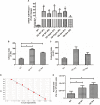Knocking Down TcNTPDase-1 Gene Reduces in vitro Infectivity of Trypanosoma cruzi
- PMID: 32256481
- PMCID: PMC7094052
- DOI: 10.3389/fmicb.2020.00434
Knocking Down TcNTPDase-1 Gene Reduces in vitro Infectivity of Trypanosoma cruzi
Abstract
Ecto-Nucleoside Triphosphate Diphosphohydrolases are enzymes that hydrolyze tri- and/or diphosphate nucleosides. Evidences pointed out to their participation in Trypanosoma cruzi virulence, infectivity, and purine acquisition. In this study, recombinant T. cruzi knocking out or overexpressing the TcNTPDase-1 gene were built, and the role of TcNTPDase-1 in the in vitro interaction with VERO cells was investigated. Results show that epimastigote forms of hemi-knockout parasites showed about 50% lower level of TcNTPDase-1 gene expression when compared to the wild type, while the T. cruzi overexpressing this gene reach 20 times higher gene expression. In trypomastigote forms, the same decreasing in TcNTPDase-1 gene expression was observed to the hemi-knockout parasites. The in vitro infection assays showed a reduction to 51.6 and 59.9% at the adhesion and to 25.2 and 26.4% at the endocytic indexes to the parasites knockout to one or other allele (Hygro and Neo hemi-knockouts), respectively. In contrast, the infection assays with T. cruzi overexpressing TcNTPDase-1 from the WT or Neo hemi-knockout parasites showed an opposite result, with the increasing to 287.7 and 271.1% at the adhesion and to 220.4 and 186.7% at the endocytic indexes, respectively. The parasitic load estimated in infected VERO cells by quantitative real time PCR corroborated these findings. Taken together, the partial silencing and overexpression of the TcNTPDase-1 gene generated viable parasites with low and high infectivity rates, respectively, corroborating that the enzyme encoded for this gene plays an important role to the T. cruzi infectivity.
Keywords: TcNTPDase-1; Trypanosoma cruzi; infectivity; knockout; virulence.
Copyright © 2020 Silva-Gomes, Rampazzo, Moreira, Porcino, Santos, Krieger, Vasconcelos, Fragoso and Moreira.
Figures







Similar articles
-
Overexpression of TcNTPDase-1 Gene Increases Infectivity in Mice Infected with Trypanosoma cruzi.Int J Mol Sci. 2022 Nov 24;23(23):14661. doi: 10.3390/ijms232314661. Int J Mol Sci. 2022. PMID: 36498985 Free PMC article.
-
Nucleoside triphosphate diphosphohydrolase1 (TcNTPDase-1) gene expression is increased due to heat shock and in infective forms of Trypanosoma cruzi.Parasit Vectors. 2014 Oct 5;7:463. doi: 10.1186/s13071-014-0463-0. Parasit Vectors. 2014. PMID: 25287580 Free PMC article.
-
Ectonucleotidases from trypomastigotes from different sources and various genetic backgrounds of Trypanosoma cruzi potentiate their infectivity and host inflammation.Cytokine. 2020 Dec;136:155255. doi: 10.1016/j.cyto.2020.155255. Epub 2020 Aug 28. Cytokine. 2020. PMID: 32866897
-
Autophagy: A necessary process during the Trypanosoma cruzi life-cycle.Virulence. 2019 Dec;10(1):460-469. doi: 10.1080/21505594.2018.1543517. Epub 2018 Nov 29. Virulence. 2019. PMID: 30489206 Free PMC article. Review.
-
Enucleated L929 cells support invasion, differentiation, and multiplication of Trypanosoma cruzi parasites.Infect Immun. 2007 Aug;75(8):3700-6. doi: 10.1128/IAI.00194-07. Epub 2007 May 14. Infect Immun. 2007. PMID: 17502387 Free PMC article. Review.
Cited by
-
Overexpression of TcNTPDase-1 Gene Increases Infectivity in Mice Infected with Trypanosoma cruzi.Int J Mol Sci. 2022 Nov 24;23(23):14661. doi: 10.3390/ijms232314661. Int J Mol Sci. 2022. PMID: 36498985 Free PMC article.
-
Synthesis of new non-natural L-glycosidic flavonoid derivatives and their evaluation as inhibitors of Trypanosoma cruzi ecto-nucleoside triphosphate diphosphohydrolase 1 (TcNTPDase1).Purinergic Signal. 2024 Aug;20(4):399-419. doi: 10.1007/s11302-023-09974-7. Epub 2023 Nov 17. Purinergic Signal. 2024. PMID: 37975950 Free PMC article.
-
E-NTPDases: Possible Roles on Host-Parasite Interactions and Therapeutic Opportunities.Front Cell Infect Microbiol. 2021 Nov 9;11:769922. doi: 10.3389/fcimb.2021.769922. eCollection 2021. Front Cell Infect Microbiol. 2021. PMID: 34858878 Free PMC article. Review.
References
-
- Bermudes D., Peck K. R., Afifi M. A., Beckers C. J., Joiner K. A. (1994). Tandemly repeated genes encode nucleoside triphosphate hydrolase isoform secreted into the parasitophorous vacuole of Toxoplasma gondii. J. Biol. Chem. 269 29252–29260. - PubMed
LinkOut - more resources
Full Text Sources

